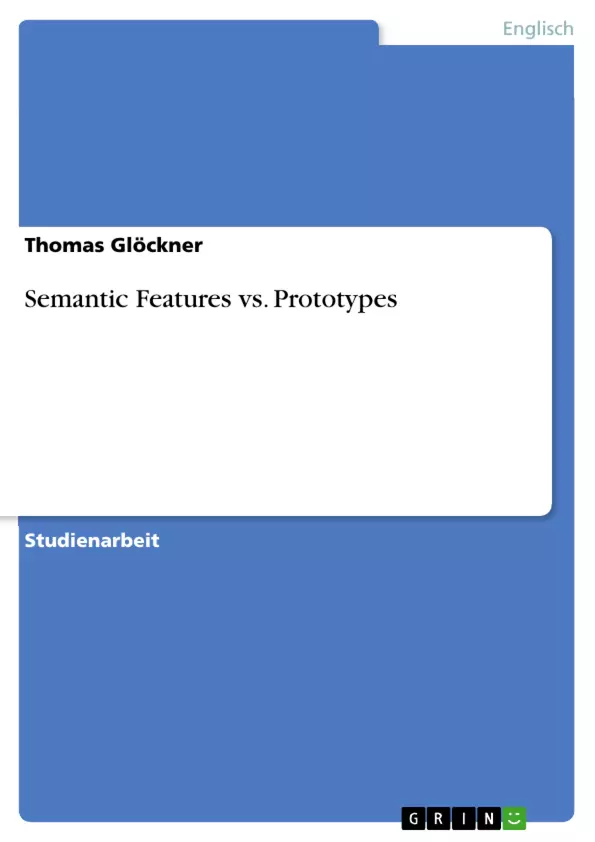1 Introduction
According to Aristotle, every word is to be defined by naming its genus proximum and differentia specifica.
The linguistic debate concerning the issue of word-meaning and its adequate description has split researchers into two opposing parties. Traditional linguists whose position is relatively close to Aristotle´s idea favour a theory called Feature Semantics (hereafter FS) whereas many scientists rather support a more modern approach which can be labelled Prototype Theory (hereafter PT).
The aim of this research paper is to describe and compare these two concepts. As a conclusion of the first (theoretical) part, it will try to show that the two approaches are not incompatible but that they even seem to function on a complementary basis. In the second (more practical) part, I will try to decompose the meaning elements of some verbs of selected English semantic fields and thus give an example for the use (and usefulness) of semantic features.
[...]
Inhaltsverzeichnis
- Introduction
- Feature Semantics vs. Prototype Theory
- Traditional Feature Theory: `Checklists´ and `Atomic Globules´
- Prototype Theory
- Need FS and PT Really Be Conflicting Views ?
- Lipkas Typology of Semantic Features
- An Attempt to Decompose the Meaning Elements of Selected English Verbs
- Preliminary Remarks
- The Word-Field of `to attack`
- The Word-Field of `to cry`
- The Word-Field of `to throw`
- Summary
Zielsetzung und Themenschwerpunkte
Diese Seminararbeit befasst sich mit dem Vergleich zweier gegensätzlicher Ansätze zur Beschreibung von Wortbedeutungen: der Merkmalsemantik (FS) und der Prototypensemantik (PT). Das Hauptziel ist es, die beiden Konzepte zu beschreiben, zu vergleichen und zu zeigen, dass sie nicht unbedingt unvereinbar sind, sondern sich möglicherweise sogar ergänzen. Ein praktischer Teil wendet die gewonnenen Erkenntnisse auf die Dekomposition der Bedeutungselemente ausgewählter englischer Verben an.
- Vergleich von Merkmalsemantik und Prototypensemantik
- Analyse der Stärken und Schwächen der traditionellen Merkmalsemantik
- Die Problematik „unscharfer Bedeutungen“ im Kontext der Merkmalsemantik
- Anwendung semantischer Merkmale zur Dekomposition von Wortbedeutungen
- Die Möglichkeit der komplementären Anwendung von FS und PT
Zusammenfassung der Kapitel
Introduction: Die Einleitung stellt die beiden zentralen Konzepte der Arbeit, die Merkmalsemantik (FS) und die Prototypensemantik (PT), vor und skizziert den Forschungsansatz. Sie verortet die Arbeit im Kontext der traditionellen und modernen Linguistik und legt die Zielsetzung dar: einen Vergleich der beiden Theorien und deren mögliche komplementäre Anwendung zu demonstrieren. Die Arbeit gliedert sich in einen theoretischen und einen praktischen Teil, wobei letzterer die Anwendung semantischer Merkmale an ausgewählten englischen Verben illustriert.
Feature Semantics vs. Prototype Theory: Dieses Kapitel vergleicht die Merkmalsemantik und die Prototypensemantik. Es beginnt mit einer detaillierten Erläuterung der traditionellen Merkmalsemantik, die die Bedeutung von Wörtern als Bündel atomarer Bedeutungskomponenten ("atomic globules") versteht. Die Schwächen dieses Ansatzes, insbesondere die Unfähigkeit, "unscharfe Bedeutungen" zu erfassen, werden kritisch beleuchtet. Im Gegensatz dazu wird die Prototypensemantik vorgestellt, welche die Bedeutung von Wörtern über Prototypen und deren Ähnlichkeitsrelationen definiert. Der Abschnitt diskutiert die Frage, ob die beiden Ansätze unvereinbar sind oder ob sie sich ergänzen können, wobei die Argumentation auf die komplementären Stärken beider Theorien hindeutet.
An Attempt to Decompose the Meaning Elements of Selected English Verbs: Dieses Kapitel wendet die theoretischen Überlegungen des vorherigen Kapitels auf die praktische Analyse von englischen Verben an. Es untersucht ausgewählte Wortfelder und demonstriert, wie die Bedeutungselemente der jeweiligen Verben mithilfe semantischer Merkmale zerlegt werden können. Durch die Analyse von Beispielverben soll die Nützlichkeit und Anwendbarkeit semantischer Merkmale in der praktischen linguistischen Analyse veranschaulicht werden. Die einzelnen Wortfelder bieten konkrete Beispiele für die Anwendung der in Kapitel 2 vorgestellten Konzepte.
Schlüsselwörter
Merkmalsemantik, Prototypensemantik, Wortbedeutung, semantische Merkmale, Bedeutungskomponenten, "atomic globules", "fuzzy meanings", Wortfeldanalyse, englische Verben.
Häufig gestellte Fragen (FAQ) zur Seminararbeit: Merkmalsemantik vs. Prototypensemantik
Was ist das Thema der Seminararbeit?
Die Seminararbeit vergleicht zwei gegensätzliche Ansätze zur Beschreibung von Wortbedeutungen: die Merkmalsemantik (FS) und die Prototypensemantik (PT). Sie untersucht deren Stärken und Schwächen und erörtert die Möglichkeit einer komplementären Anwendung.
Welche Ziele verfolgt die Arbeit?
Das Hauptziel ist es, FS und PT zu beschreiben, zu vergleichen und aufzuzeigen, dass sie nicht unbedingt unvereinbar sind. Ein weiterer Fokus liegt auf der praktischen Anwendung der gewonnenen Erkenntnisse durch die Dekomposition der Bedeutungselemente ausgewählter englischer Verben.
Welche Konzepte werden im Detail behandelt?
Die Arbeit behandelt die traditionelle Merkmalsemantik mit ihren "Checklisten" und "atomaren Bedeutungskomponenten", die Prototypensemantik mit ihren Prototypen und Ähnlichkeitsrelationen, Lipkas Typologie semantischer Merkmale und die Problematik "unscharfer Bedeutungen" im Kontext der Merkmalsemantik.
Wie ist die Arbeit strukturiert?
Die Arbeit gliedert sich in einen theoretischen Teil (Vergleich von FS und PT) und einen praktischen Teil (Analyse englischer Verben). Der theoretische Teil erläutert die beiden Theorien und diskutiert deren mögliche Vereinbarkeit. Der praktische Teil demonstriert die Anwendung semantischer Merkmale an ausgewählten englischen Verben (z.B. "to attack", "to cry", "to throw").
Welche englischen Verben werden analysiert?
Die Arbeit analysiert die Wortfelder der englischen Verben "to attack", "to cry" und "to throw", um die Anwendung semantischer Merkmale zur Dekomposition von Wortbedeutungen zu veranschaulichen.
Welche Schlussfolgerungen zieht die Arbeit?
Die Arbeit argumentiert, dass FS und PT sich nicht unbedingt ausschließen, sondern sich möglicherweise ergänzen können. Die praktische Analyse der englischen Verben soll die Nützlichkeit und Anwendbarkeit semantischer Merkmale in der linguistischen Analyse zeigen.
Welche Schlüsselwörter beschreiben die Arbeit am besten?
Merkmalsemantik, Prototypensemantik, Wortbedeutung, semantische Merkmale, Bedeutungskomponenten, "atomic globules", "fuzzy meanings", Wortfeldanalyse, englische Verben.
Für wen ist diese Arbeit relevant?
Diese Arbeit ist relevant für Studierende und Wissenschaftler im Bereich der Linguistik, insbesondere der Semantik, die sich mit der Beschreibung und Analyse von Wortbedeutungen befassen.
- Quote paper
- Thomas Glöckner (Author), 1997, Semantic Features vs. Prototypes, Munich, GRIN Verlag, https://www.grin.com/document/616



